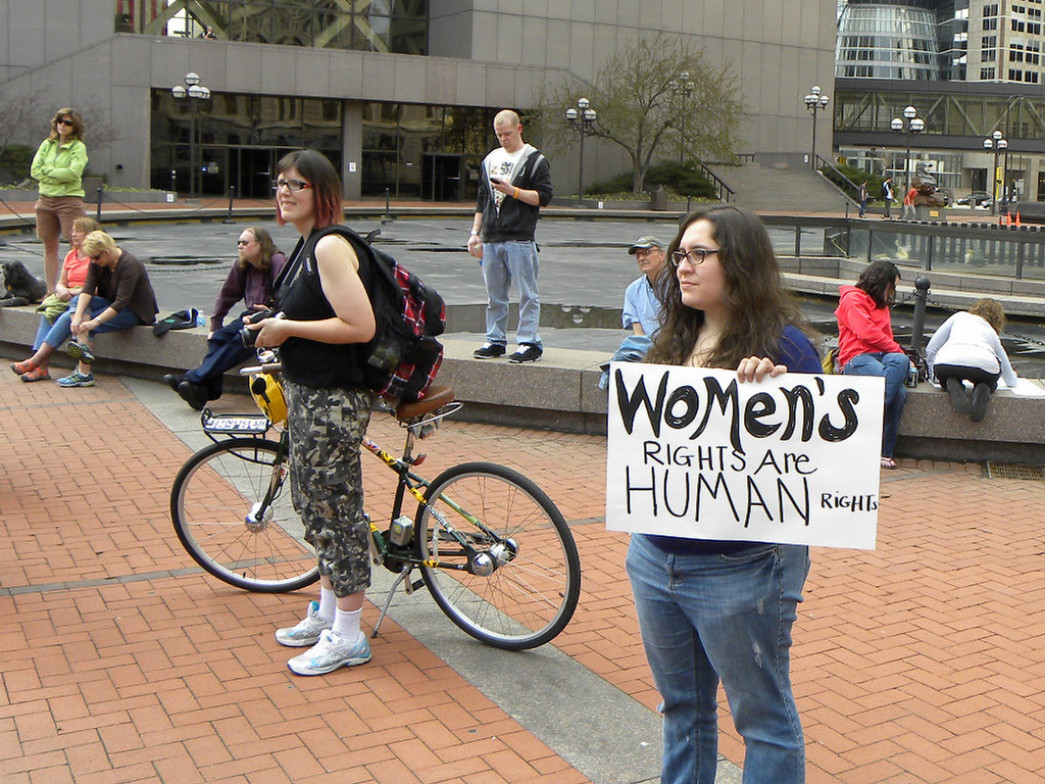
Female Genital Mutilation is Detrimental to Human Rights and We Need to Stop It

Written by: Virak Kanhapich, a 3rd year student majoring in Global Affairs at The American University of Phnom Penh
Editted by: Heng Kimkong, a Visiting Senior Research Fellow at Cambodia Development Center and a PhD Candidate in Education at The University of Queensland, Australia

(Photo Credit: "Occupy Women's Rights - A rally to honor the many struggles for women's liberty" by Fibonacci Blue is licensed under CC BY 2.0)
Female genital mutilation (FGM), according to the World Health Organization, is a procedure involving the partial or total removal of the external female genitalia or genital organs without any medical reasons. Although it is a huge concern to human rights, it is still being practiced widely. It has been documented in 30 countries, mainly in Africa, Asia and the Middle East. FGM is usually carried out by health care providers and mostly by traditional circumcisers; however, it is an extremely unsafe procedure. In the world, about 200 million girls have suffered from female genital mutilation. FGM remains common in Somalia, Mali, Gambia, Guinea Bissau, Chad and Senegal today. Notwithstanding the fact that 31 countries have legislated against FGM, the practice will not come to an end as long as the social norms and religious beliefs remain the same.
There is a need for an understanding of the difference between upholding a traditional or religious belief and outrightly violating human rights. The mental and physical health risks that come with FGM deserve a careful attention. Based on the World Health Organization, there are four major types of FGM. Type 1 is the partial or total removal of the clitoral glans and the prepuce or clitoral hood. Type 2 is the partial or total removal of the clitoral glans and the labia minora and with or without removal of the labia majora. Type 3 is a procedure that narrows the vaginal opening through the creation of a covering seal. The seal is formed by cutting and repositioning the labia minora, sometimes through stitching, with or without the removal of the clitoral prepuce/clitoral hood and glans. Lastly, Type 4 includes harmful procedures to the female genitalia for non-medical purposes such as pricking, piercing, incising, scraping, and cauterizing the genital area. There are no health benefits to FGM at all. As reported by Nowak, “FGM can harms girls enormously with health risks such as chronic pain, chronic pelvic infections, development of cysts, abscesses and genital ulcers, excessive scar tissue formation, infection of the reproductive system, decreased sexual enjoyment, urinary and menstrual problems, and psychological factors like post-traumatic stress disorder. It could even lead to severe bleeding that ultimately causes death.”
Thus, FGM is harmful and cruel, but why is it still practiced widely? In fact, FGM is carried out due to various factors linked to the structural conditions of particular ethnic groups or countries. FGM arises from gender inequality as some communities carry it out in order to control girls’ sexuality. It is closely linked to child marriage because it is believed that FGM is able to enhance fertility. Girls who oppose or reject the procedures are deemed ineligible for marriage. Another factor is related to femininity as, in some society, women are often perceived to be unclean if their genitals are uncut. As a study by Kontoyannis and Katsetos showed, for many African families, cultural identity plays a key role in social acceptability even if it is at the cost of their daughter's rights. Furthermore, male figures take a huge part in sustaining the practice, as oftentimes it is male family members who make major decisions concerning girls’ lives and well-being. Moreover, FGM is usually performed in a ritualistic way because it is believed to uplift spirituality. This tradition is inherently concerning as women deserve and shall have the sole rights to their own life’s choices and take part in the decision making process.
FGM is an inhuman procedure that is a huge violation of female rights because oftentimes women do not consent to such practices. It is completely against the right to the physical integrity of girls. With the victim mostly aged from 0 to 15 years, FGM violates children's rights as defined in the Convention on the Rights of the Child (CRC). Article 2 of the CRC is about the right to be free from discrimination, while Article 19 mentions the right to be protected from all forms of mental and physical violence and maltreatment. Moreover, the right to a highest attainable standard of health (Article 24) and the right of freedom from torture or other cruel, inhuman or degrading treatment or punishment (Article 37) are also outlined in the CRC. Not only is FGM a serious violation of human rights, but it is also discrimination against girls as it is not practiced on young boys. This action will lead to serious consequences for girls' well-being and ability to contribute positively to society. It negatively impacts girls' development and could further create a sense of self-hatred.
Every major religion seems to have aspects that constrict the rights of women, so there is a need to address the battle between modern women's rights and what is practiced by different religious groups. Freedom of religion cannot justify the gruesome and unlawful procedure being done to girls. It can be augured that the promotion of human rights and the prohibition of FGM can be seen as a restriction on the freedom of religion: however, we should recognize that it is nothing but a pure human tragedy. The freedom of religion as defined by Universal Rights Organization is about “ protecting individuals’ and groups’ right to have, adopt or change a religion or belief; to manifest and practice this religion or belief, alone or in community with others; and to be free from coercion and discrimination on the grounds of their religion or belief not a protection of religion”. In addition, numerous researchers assert that as the practice intends to control women’s sexuality and freedom, it is a clear demonstration of gender-based human rights violation. Henceforth, it can be concluded that the FGM practice is clearly a gender-based discrimination against women and a violation of women’s rights.
Thus far, UNFPA, UNICEF, WHO, and the UN General Assembly have taken actions to fully ban this practice globally. However, the elimination of FGM requires cooperative actions from all stakeholders including families, communities, and the authority. Law enforcement and political commitment at national and international levels are also needed. The FGM practice will be greatly reduced if everybody comes together and joins hands to abandon it. The prevalence of FGM is rooted in beliefs, attitudes, norms, and systematic views. Policy responses and a collective action are, therefore, needed to address this issue to protect girls’ rights.
The reprehensible practice of FGM is justified under false semblance of some societies to perpetuate the unbalanced power structure or maintain the status quo; however, it is possible to put an end to this brutal practice if we act now. A legal approach, a greater awareness by the international community and the invocation of human rights standards are vital to the abandonment of FGM. Together, we can put an end to female genital mutilation.
*This blog is produced with the financial support from the European Union and The Swedish International Development Cooperation Agency through Transparency International Cambodia and ActionAid Cambodia. Its contents do not reflect the views of any donors.




